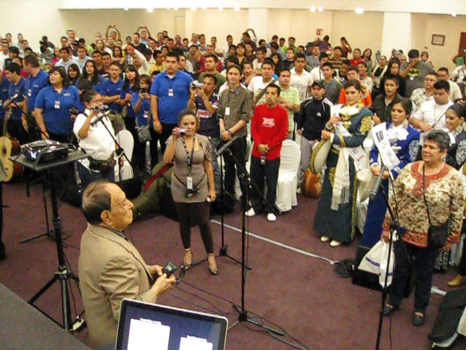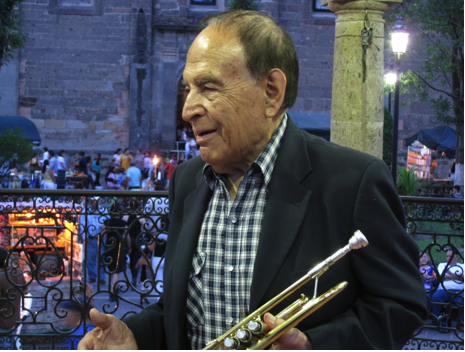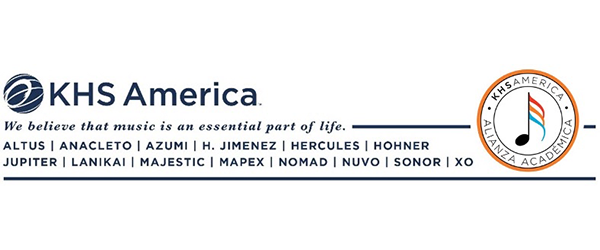By Jonathan Clark
Few would dispute the fact that 89-year-old maestro Miguel Martínez is the most influential instrumentalist in the history of mariachi music. He not only established the performance standard for the solo mariachi trumpet, but also defined and popularized the two-trumpet mariachi practice. Furthermore, he is a distinguished and prolific author of popular songs and mariachi instrumental standards. But, as the proverb goes, ‘No one is a prophet in his own land,’ and, until quite recently, the Mexican news media virtually ignored Martínez, even though numerous articles about and interviews with him have appeared abroad. (To give an example, he was a principal figure in The History Channel’s recent documentary El Mariachi.)
The Encuentro Internacional del Mariachi was founded in 1994 by the Guadalajara Chamber of Commerce. Today, it is the largest mariachi festival in the world, and the one that features the most groups from different countries. When it began, this festival featured seldom-seen, rural, old-style and even indigenous groups in addition to contemporary ensembles, but the participation of the more traditional mariachis was soon almost eliminated. In 2002, to give greater exposure to this undervalued facet of Mexican folklore, Cornelio García of Jalisco’s Secretariat of Popular Culture organized the first Encuentro de Mariachi Tradicional, where one of the basic rules was that participating groups may not include the trumpet. The Encuentro Internacional del Mariachi and the Encuentro Nacional de Mariachi Tradicional were eventually scheduled back-to-back into a two-week celebration of mariachi music. Today, the two encuentros compliment each other magnificently, with the Encuentro Internacional devoted mainly to the commercial aspect and the Encuentro Tradicional mainly to the cultural aspect of mariachi music, although there is considerable overlap.
The scope of this two-week celebration is far too broad to cover here – this year’s Encuentro Tradicional included over 30 separate events, and the Encuentro Internacional over 100. This article will focus mainly on the contributions of Miguel Martínez to both encuentros.
 One of unscheduled highlights of the 10th annual Encuentro Tradicional was the impromptu fandangos that were held each night in the lobby of the host hotel, the downtown Aranzazú Eco. Couples danced to the accompaniment of arpa grande, guitarra de golpe, and violin upon a wooden tarima or dance platform that was brought in for the occasion. Dancers, singers, and musicians traded off continuously, and sometimes participants played percussion on the sounding board of the harp. The enthusiasm was tremendous, the crowds large, and the festivities frequently continued into the early hours of the morning. It was traditional mariachi music in its purest form, in a setting rarely found in an urban environment
One of unscheduled highlights of the 10th annual Encuentro Tradicional was the impromptu fandangos that were held each night in the lobby of the host hotel, the downtown Aranzazú Eco. Couples danced to the accompaniment of arpa grande, guitarra de golpe, and violin upon a wooden tarima or dance platform that was brought in for the occasion. Dancers, singers, and musicians traded off continuously, and sometimes participants played percussion on the sounding board of the harp. The enthusiasm was tremendous, the crowds large, and the festivities frequently continued into the early hours of the morning. It was traditional mariachi music in its purest form, in a setting rarely found in an urban environment
 Nightly fandango in the Hotel Aranzazú lobby
Nightly fandango in the Hotel Aranzazú lobby
For many of us city dwellers, this was our first opportunity to witness and participate in a traditional fandango. It was an education for don Miguel as well, and he and his wife could be found in the lobby nightly, experiencing it. “I had read and heard about these events, but this was the first time I actually got to see one,” he said. “All the years I traveled with Mariachi Vargas and other groups, we never encountered one. I never knew what a tarima looked like or how couples danced on it. What feet of steel! And I’d never actually seen anyone play percussion on a harp until now,” he assured me. “I’m really glad to see this Tierra Caliente tradition preserved not just by the older generation, but by young folks as well.”
Although it would have been more logical for the contemporary Encuentro Internacional to invite Miguel Martínez to Guadalajara, it was Ignacio Bonilla Arroyo, director of Culturas Populares de Jalisco and of the Encuentro Tradicional, who initially had the vision to invite the maestro to participate in the colloquium The Mariachi, a Mexican Cultural Heritage, held August 25-26 at El Colegio de Jalisco, in the Guadalajara municipality of Zapopan.
 Colloquium at the Colegio de Jalisco
Colloquium at the Colegio de Jalisco
The second day of the colloquium opened on Friday, August 26, with the hour-long presentation “Miguel Martínez: Patriarch of the Mariachi Trumpet.” There I had the honor of presenting the legendary maestro in a live interview in which he responded to key questions, reinforced by images and sound that included historical photographs and fragments from his many classic recordings. Miguel Martínez is the most engaging storyteller of any mariachi musician I’ve ever met, and he captivates every audience he speaks to. The small group at this event was no exception.
That afternoon, at the host hotel, Martínez gave a similar presentation for Encuentro de Mariachi Tradicional participants. There, the crowd was much larger. Even though none of the participating groups featured a trumpet, those musicians demonstrated a phenomenal interest in the story of how that instrument became part of the mariachi. As a principal protagonist of that evolution, Martínez spoke with spellbinding authority, and the audience responded with great reverence. Dozens of traditional musicians approached him afterward with questions, congratulations, and requests for autographs and photos with him. One musician from Michoacán said, “Maestro, where I come from, the conjuntos de arpa don’t use a trumpet, but I just wanted to let you know that all my life I’ve admired your playing on recordings, and your trumpet continues to give me joy.” At the end of the presentation, Armando Cervantes Tinoco, director of the music workshops for the Encuentro Internacional del Mariachi, invited don Miguel to speak at that event the following Monday.
 Interview on Argentinian television
Interview on Argentinian television
The following day, in San Pedro Tlaquepaque, the University of Guadalajara’s Channel 44 videotaped what was probably Martínez’s first feature interview for Mexican television, for the series Se Va y Se Corre. Later, a crew from Argentinian television convinced don Miguel to give them an interview as well. After the videotaping, the crew invited Miguel, his wife, and I to have dinner with them in the famous Parián restaurant complex. Local mariachis immediately recognized don Miguel, and surrounded him continuously for the hour or so we were there.
 Guadalupe Vallejo de Martínez, Miguel Martínez, and Ignacio Bonilla display Galardón award
Guadalupe Vallejo de Martínez, Miguel Martínez, and Ignacio Bonilla display Galardón award
At the Gala de Mariachi Tradicional held on Sunday evening, August 28, in the Teatro Degollado, Miguel Martínez was presented with the Galardón Mariachi, a trophy and diploma awarded to guardians of the mariachi tradition whose careers demonstrate indisputable merit. The diploma read: “To don Miguel Martínez, for his immense contribution to traditional mariachi music.” It was the first time the maestro had ever received an award in Guadalajara. “It made me extremely happy to see him honored,” said former Mariachi Vargas member Rigoberto Alfaro, who was present as a judge in the mariachi competition. “Any homage that could be paid to don Miguel Martínez is insufficient compared to what the man deserves. No one in mariachi music has ever equaled him,” concluded Alfaro.
 With former bandmate Rigoberto Alfaro
With former bandmate Rigoberto Alfaro
This gala event officially closed the 2011 Encuentro de Mariachi Tradicional, but the fandango at the Aranzazú Hotel continued almost until daybreak.
 Armando Cervantes Tinoco presents the maestro at Encuentro Internacional opening ceremony
Armando Cervantes Tinoco presents the maestro at Encuentro Internacional opening ceremony
When we arrived at the opening ceremony of the 18th Encuentro Internacional del Mariachi on Monday morning, August 29, we were immediately overwhelmed by the large number of students present in the immense ballroom, representing over 50 groups, at least half of which had come from outside Mexico. Don Miguel was scheduled to speak for an hour, and the time flew by. When the hour was up, I announced that we’d have to continue the talk another day. “Nooo!” roared the crowd. “We want to hear more!” Don Miguel was given an additional half-hour, which allowed him to satisfy the crowd and come to an acceptable conclusion. An hour after the talk ended, there were still lines of people waiting for autographs and photos with the maestro. When we finally managed to return to the lobby of our hotel across the street, he was surrounded by yet another crowd.
 Addressing students at the XVIII Encuentro Internacional del Mariachi
Addressing students at the XVIII Encuentro Internacional del Mariachi
That afternoon, we traveled to Lake Chapala, an hour’s drive from Guadalajara, where the Hernández brothers had organized a barbecue in don Miguel’s honor. Antonio, Pedro (Pedro Rey), Crescencio, and José Hernandez—all accomplished trumpet players—were present, as was the renowned Jesús Rodríguez de Híjar. It was a suitable ending to a triumphant visit to Jalisco. The following day, Martínez and his wife returned, tired but contented, to their home near Mexico City.
 In Chapala with Pedro (Rey) Hernández, Jesús Rodríguez de Híjar, Jonathan Clark, Crescencio Hernández, Miguel Martínez, José Hernández, and Antonio Hernández
In Chapala with Pedro (Rey) Hernández, Jesús Rodríguez de Híjar, Jonathan Clark, Crescencio Hernández, Miguel Martínez, José Hernández, and Antonio Hernández
Although a large number of mariachi festivals are held annually in North America and other parts, the seminal musicians who forged the mariachi tradition are seldom honored at these events. “On the final day, musicians from Venezuela, Colombia, Ecuador, Peru, Nicaragua, Honduras, Mexico, USA, and other countries came up to me and said they’d been wanting to meet me for years. They asked me why I hadn’t come to this event earlier,” said don Miguel. “‘I think they had me in the refrigerator,’ I answered. ‘All they had to do was invite me.’”
It took over 70 years of artistic labor before the patriarch of the mariachi trumpet was officially recognized in Guadalajara, the land of the mariachi. But, as the saying goes, ‘Better late than never.’








Wish I could have been there. This was a once in a lifetime event!
Why not bring him to San Antonio, TX?
Felicidades Tocayo Y Felicidades Maestro Martinez!!!
Fue un placer y un honor recibirlos en Tucson este Abril pasado y ojala que siguen promoviendo el arte y la magia del Mariachi y toda su historia.
Su Amigo,
John Contreras
Tucson, AZ
Hello Jonathan! Que bonita! I wish I was there also – I’ll never forget him teaching in Albuquerque in ?1995 or what year was it? Anyway, how are you? Such a beautiful tribute to a lovely, talented gentleman! I have his autograph twice, recently at the Radio Bilingue concert in famous Oakland, CA…last year. El tiempo vuela, si? Please phone when you have a minute 510-604-1823 (tambien, mira nuestro fotos de Mexican Museum concert de SF 2 semanas pasado.) Muchas gracias senor,
de Linda Meneken, Homegirl (named by Dolores Huerta at her birthday party!)
P.S. When he turns 90, we ?someone should do a big party in Guad????